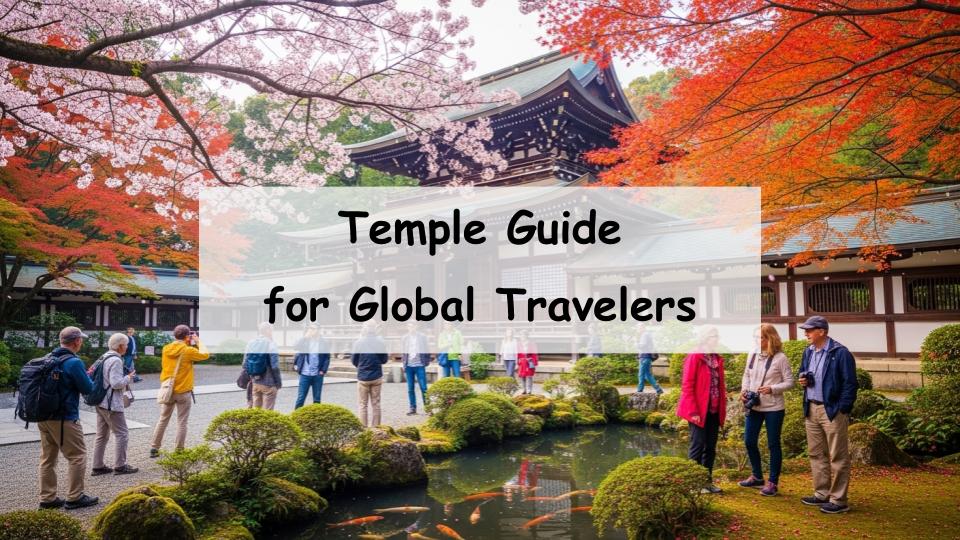Japan’s temples are captivating destinations where visitors can experience the nation’s rich culture and deep history. But many travelers may wonder, “Which temples in Japan are easiest for foreign tourists to visit?” This guide answers that question by introducing five tourist-friendly temples and highlighting key tips for a respectful and enjoyable visit. Whether it’s your first time in Japan or your tenth, this article will help you plan a meaningful and stress-free temple experience.
Why Temples Are So Appealing to Foreign Visitors
The Historical and Cultural Value of Temples
Temples in Japan are more than just places of worship—they are gateways to centuries of tradition. From architectural wonders to serene gardens and priceless art, each temple tells a story of the nation’s spiritual and cultural evolution. Exploring these sacred sites allows visitors to connect with Japan’s past while appreciating its present-day reverence for harmony and beauty.
What Makes a Temple Tourist-Friendly?
Foreign visitors often prefer temples that are easy to reach, offer multilingual signs or guides, and provide structured experiences such as guided tours or cultural activities. Clean facilities, friendly staff, and scenic surroundings also play a big role. Temples that accommodate these needs naturally become popular among international travelers.
5 Temples in Japan That Are Easy for Tourists to Visit
Kiyomizu-dera (Kyoto)
Located in the heart of Kyoto, Kiyomizu-dera is a UNESCO World Heritage site known for its dramatic wooden terrace overlooking the city and beautiful seasonal landscapes. With multilingual signage and easy access from public transportation, it’s a top choice for foreign tourists looking to soak in Kyoto’s traditional charm.
Todai-ji (Nara)
Todai-ji is home to Japan’s largest bronze Buddha statue and boasts an expansive temple complex. Situated within walking distance of Nara Park and well-marked for international visitors, it offers a powerful glimpse into Japan’s Buddhist heritage while being highly accessible.
Senso-ji (Tokyo)
Tokyo’s oldest temple, Senso-ji, is located in the bustling Asakusa district. The iconic red Kaminarimon gate and shopping streets around the temple make it a lively destination for first-time visitors. Multilingual resources and convenient transportation make it ideal for a short yet impactful temple visit in the capital.
Kotoku-in (Kamakura)
Known for its towering Great Buddha, Kotoku-in in Kamakura is a popular stop for history enthusiasts. Surrounded by natural beauty and traditional streets, the temple offers a quiet, reflective atmosphere and is only an hour from central Tokyo by train.
Myoryu-ji (Kanazawa)
Nicknamed the “Ninja Temple,” Myoryu-ji features hidden passages, trap doors, and secret stairways that fascinate visitors. Guided tours are available in English and other languages, making it an exciting and unique cultural experience in Kanazawa.
Key Tips for Visiting Temples in Japan
Basic Etiquette and Temple Manners
Temples are sacred spaces, so quiet behavior and respectful actions are essential. Learn simple rituals such as purifying your hands at the water basin and bowing at the main hall. Always check for signs indicating whether photography is allowed and avoid disruptive behavior.
Common Challenges for Foreign Visitors
Some temple customs—like removing shoes before entering or knowing the proper way to offer coins and pray—can be confusing for newcomers. To avoid embarrassment, it’s a good idea to read basic etiquette guides or join a tour with an experienced guide who can explain these traditions.
Dress Code and What to Bring
While most temples don’t enforce a strict dress code, modest and respectful attire is encouraged. Avoid revealing clothing, especially when entering inner sanctuaries. Bring minimal belongings and consider wearing slip-on shoes for convenience when entering buildings where shoes must be removed.
Enhancing Your Temple Experience
Take Advantage of Guided Tours and Audio Guides
Many temples now offer English-speaking guides or audio tour devices that explain the history and significance of each area. These services can significantly enrich your experience and provide deeper context. Check the temple’s website in advance for availability and reservation details.
Visit During Seasonal Events and Festivals
Temples are particularly beautiful during cherry blossom season in spring and the colorful foliage of autumn. Many also host seasonal festivals and ceremonies that offer a deeper connection to local customs. Planning your visit around these events can make your trip even more memorable.










Comment